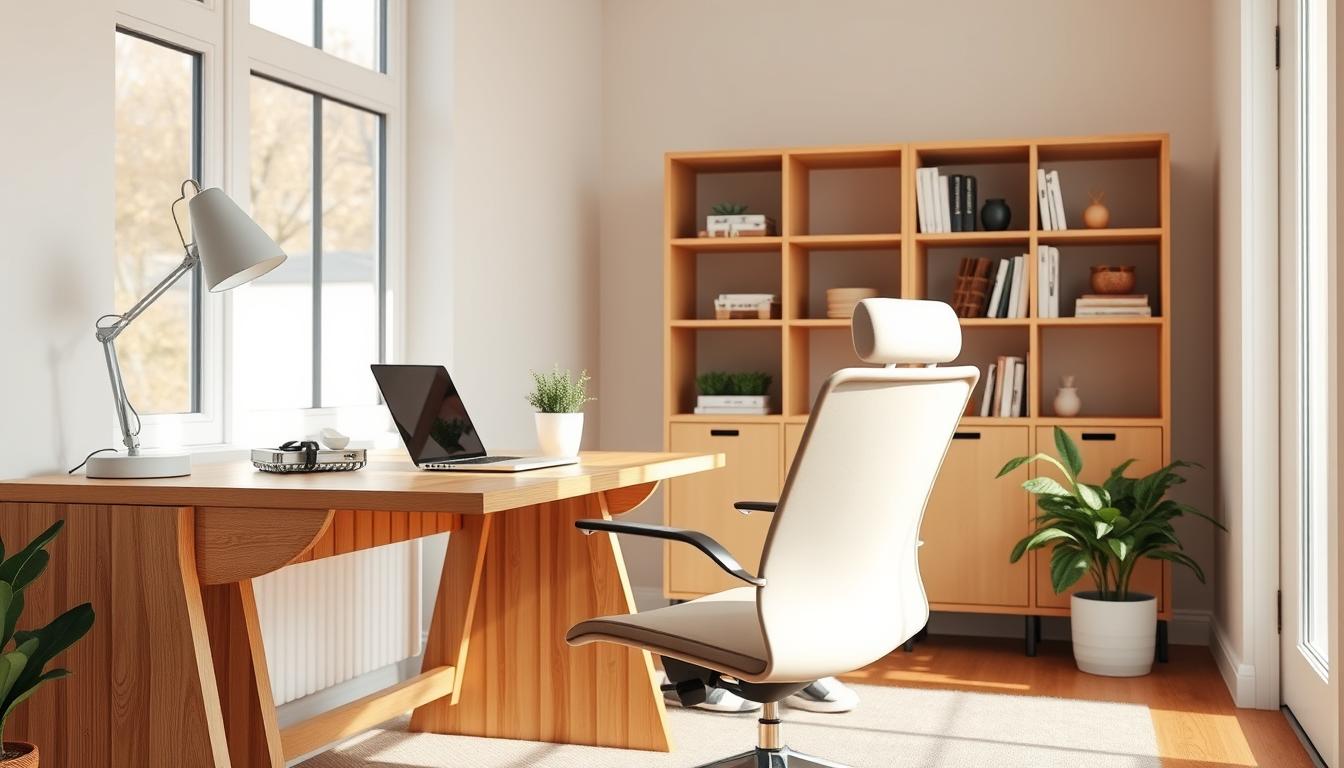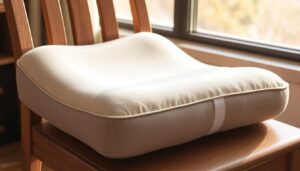More moms are working from home now. This means they have to balance work and family life. Having a good effective home office is key for staying productive and feeling good. A well-made workspace helps moms manage work and family better. An ergonomic workspace is especially important. It helps avoid health problems from too much sitting. Setting up a efficient home office helps moms stay focused and happy at work. This article will show you how to make your desk ergonomic. We’ll also give tips for a productive workspace and the right ergonomic desk setup for moms.
Key Takeaways
- Create a dedicated workspace to improve focus and productivity.
- Invest in ergonomic furniture to prevent health issues.
- Minimize distractions to achieve a better work-life balance.
- Consider the lighting and noise levels in your home office.
- Organize your workspace to reduce clutter and increase efficiency.
The Unique Challenges of Remote Work for Mothers
Remote work has brought new challenges for mothers. They face physical, mental, and environmental hurdles. These are not always expected by remote workers.
Balancing Professional and Parenting Responsibilities
Mothers working from home find it hard to balance work and family. Family members are always around, causing interruptions.
Frequent Interruptions and Their Impact
Interruptions can hurt a mother’s work focus. Minimizing distractions is key to good work quality. Setting work time and talking to family about it helps.
Time Management Constraints
Mothers need good time management at home. They should focus on one task at a time. This way, they can manage work and family better.
Physical Strain from Multitasking
Multitasking can be hard on mothers’ bodies. It can cause bad posture and long sitting. This might lead to health problems later.
The Importance of a Dedicated Workspace
A dedicated workspace is crucial for mothers at home. It boosts productivity and reduces distractions. A good desk layout makes remote work better.
Understanding Ergonomics Basics
Ergonomics helps prevent injuries at work and makes us feel better. It’s about making sure the worker, the place, and the task fit well together. This is key to avoiding injuries and health problems.
What Is Ergonomics?
Ergonomics is about designing workspaces to be easy on the body. It makes sure the space fits the person, making work comfortable and efficient.
Why Ergonomics Matters for Long-term Health
Good ergonomics is vital for staying healthy over time. It helps stop musculoskeletal disorders at work. Key benefits include:
- Reducing the risk of injury
- Improving productivity
- Enhancing overall comfort
Preventing Repetitive Strain Injuries
Remote workers often get repetitive strain injuries (RSI) because of bad workspace setups. Ergonomic practices help a lot. They make sure the workspace supports good posture and cuts down on repetitive actions.
Reducing Back and Neck Pain
Back and neck pain often come from bad chairs and monitors. Good chairs and monitors help a lot. They make sure the back is supported and the monitor is at a good distance.
Common Ergonomic Issues in Home Offices
Home offices often miss out on ergonomic features. This leads to bad chairs, monitors in the wrong place, and not enough light.
Assessing Your Current Work Environment
It’s important to know your work area well. A good workspace boosts your work and comfort.
Identifying Pain Points in Your Setup
Look at what’s hard in your workspace. Problems like bad lighting, not enough space, and poor seated posture are common.
Conducting a Self-Assessment
Doing a deep self-assessment helps you see your workspace’s ergonomics. It’s about checking how your body feels in your space.
Body Discomfort Checklist
- Do you get back or neck pain after working?
- Is your eye tired from screen glare?
- Do you feel tired or uncomfortable after working?
Workspace Evaluation Guide
Check your workspace for things like chair height, monitor, and keyboard. A workspace evaluation finds ergonomic problems.
Recognizing Warning Signs of Poor Ergonomics
Watch for signs like pain or discomfort often. OSHA says, “Ergonomics is about fitting the job to the worker, not the worker to the job.”
“Ergonomics is about fitting the job to the worker, not the worker to the job.” – OSHA

Creating an Ergonomic Desk Setup for Moms
A good home office for moms needs to be ergonomic and adaptable. It’s not just about feeling comfy. It’s about making a space that helps with work and taking care of kids.
Essential Components of a Mother-Friendly Workspace
A space for moms should have key things for work and parenting. It should have a special area for work that’s quiet and has the right tools.
- A comfortable, adjustable chair
- A spacious desk for multiple tasks
- Good lighting that reduces eye strain
- Storage for office supplies and children’s materials
Adaptable Solutions for Changing Needs
Being able to change things up is key for a workspace. It should be easy to adjust and have furniture that does more than one thing.
Quick-Adjust Features for Interruptions
Features that can be changed fast help moms adjust to sudden needs. Like when a kid needs help with homework or a family member needs attention.
Dual-Purpose Furniture Options
Furniture that does two things, like a desk with storage or a chair that changes height, makes a workspace better.
| Furniture | Features | Benefits |
|---|---|---|
| Adjustable Desk | Height adjustment, spacious surface | Accommodates different tasks, promotes comfort |
| Ergonomic Chair | Lumbar support, adjustable height and arms | Reduces back strain, enhances comfort |
Balancing Accessibility and Privacy
It’s important to have a space that’s open for family but also private for work. Moms need a place where they can focus without distractions.
By adding these features, moms can make a desk setup that meets their needs. This makes work and comfort better.
Selecting the Right Desk
For many remote workers, especially mothers, the desk is more than just furniture. It’s a workspace that must fit their unique needs. When picking a desk, think about adjustability, space, and budget.
Height-Adjustable vs. Fixed-Height Options
Choosing between a height-adjustable or fixed-height desk is important. Height-adjustable desks let you switch between sitting and standing. This can help prevent musculoskeletal disorders. Fixed-height desks are cheaper but might need extra adjustments for ergonomics.
Space Considerations for Home Offices
Space is key in home offices. For small spaces, space-saving designs like corner desks work well. They use extra space and keep things organized.
Corner Desks and Space-Saving Designs
- Corner desks maximize available space.
- Wall-mounted desks can further enhance space efficiency.
Desks with Storage Solutions
Desks with built-in storage keep important items close. This reduces clutter and boosts productivity.
Budget-Friendly Desk Solutions
If you’re on a tight budget, there are affordable desk options. Think about repurposing furniture or finding discounts on ergonomic desks.
Choosing an Ergonomic Chair
Ergonomic chairs help avoid back pain and other issues. They are great for moms working from home.
Essential Features for Proper Support
Look for a few key things in an ergonomic chair. Lumbar support is very important.
Lumbar Support Options
Adjustable lumbar support is a must. It fits different body types. Some chairs have built-in lumbar, others have removable rolls.
Seat Depth and Width Considerations
The seat’s depth and width matter a lot. It should support your thighs without hurting your knees.
Adjustability Options to Look For
Choose a chair that can adjust a lot. Look for armrests, seat height, and tilt options.
Alternatives to Traditional Office Chairs
There are other chairs that offer extra benefits.
Exercise Balls and Kneeling Chairs
Exercise balls help your posture and core. Kneeling chairs ease back pressure.
Nursing-Friendly Seating Options
For nursing moms, a supportive chair is key. Look for reclining or nursing chairs.

Choosing the right ergonomic chair makes work better. It’s comfy and supports your health.
Optimal Monitor Placement and Screen Height
The place of your monitor affects your comfort and eye health. It’s key to place it right to avoid eye strain and feel good while working.
Proper Viewing Distance and Angle
It’s important to put your monitor at a good distance and angle. The best distance is 20 to 25 inches. It should be right in front of you or a bit off to the side.
The 20-20-20 Rule for Eye Strain
Follow the 20-20-20 rule to lessen eye strain. Every 20 minutes, look away from your screen. Then, focus on something 20 feet away for 20 seconds.
Monitor Height Calculation
The top of your monitor should be at eye level or a bit lower. This keeps your neck straight and eyes comfortable.
Multi-Monitor Setups
If you use more than one monitor, place them wisely. Your main monitor should be right in front. Other monitors should be at an angle.
Solutions for Laptop Users
Laptop users can use stands to lift their screens. Also, using an external keyboard and mouse helps keep a good posture.
Laptop Stands and External Peripherals
Laptop stands make your workspace better. Using a stand with an external keyboard and mouse helps your neck and wrists.
Portable Setup Options
For those who work outside, there are portable solutions. Laptop stands and small external devices help keep your work area ergonomic anywhere.
| Monitor Placement Tip | Description | Benefit |
|---|---|---|
| Position monitor directly in front | Place monitor at a comfortable distance | Reduces eye strain |
| Adjust monitor height | Top of monitor at eye level or slightly below | Promotes neutral neck posture |
| Use laptop stand | Elevate laptop to comfortable viewing height | Improves ergonomics for laptop users |
Keyboard and Mouse Positioning
Putting your keyboard and mouse right is key to avoiding injuries. It makes work more comfortable and productive.
Preventing Wrist Strain
Wrist strain is common for computer users. Keeping your wrists straight is very important.
Neutral Wrist Positioning
Make sure your wrists are straight when typing or using the mouse. This lessens strain on your tendons and muscles. You can adjust your chair height or use a wrist rest to do this.
Keyboard Tray Benefits
A keyboard tray helps get your keyboard at the right height. This makes your wrists stay in a natural position. It also keeps the keyboard close to your body.
Ergonomic Input Device Options
Choosing the right input devices is important. Ergonomic keyboards and mice help avoid wrist strain. They help keep your hands and wrists in natural positions.
Proper Arm and Elbow Positioning
It’s also important to position your arms and elbows right. Keep your elbows at 90 degrees and close to your body. This keeps you comfortable while working.
By paying attention to these details, you can lower the chance of discomfort and injury. This makes your work environment better for the long term.
Lighting Considerations for Eye Health
Eye health is linked to the lighting in your home office. Good lighting cuts down eye strain and boosts comfort while working.
Natural vs. Artificial Light
It’s best to mix natural and artificial light in your office. Natural light is great, but it might not be enough. This is true, especially when it’s very sunny or in dark rooms.
Artificial light can help fill in the gaps. LED bulbs are a good choice. They save energy and give off a soft light.
Reducing Screen Glare
Screen glare can hurt your eyes. Here are some tips to avoid it:
- Put your computer where it’s not in direct sunlight or harsh light.
- Use anti-glare screens or filters to cut down on reflections.
Anti-Glare Screens and Filters
Anti-glare screens and filters can go right on your monitor. They’re super helpful when you can’t avoid light.
Optimal Desk Placement for Lighting
Put your desk near a window for natural light. But, don’t let sunlight hit your screen. A desk at a 90-degree angle to the window can also help with glare.
Lighting Solutions for Video Calls
For video calls, make sure your face is lit up well. Soft, natural light or a desk lamp can help. They prevent harsh shadows and eye strain.

Creating a Flexible Workspace for Interruptions
It’s key to have a workspace that handles interruptions well. This is especially true for moms working from home. A flexible space helps moms balance work and family duties better.
Quick Transition Strategies
Being able to switch between work and family tasks quickly is important. You can do this by using one-handed work and finding save points in your work.
One-Handed Work Techniques
Learning one-handed work techniques can really help. For example, you can type or use your computer with one hand. This lets you take care of a child with the other hand, saving time and stress.
Save Points in Your Workflow
Finding save points in your work is helpful. It lets you stop work at a good spot. Then, you can pick up where you left off after an interruption. This could be at the end of a section or after finishing a task.
Organizing for Efficiency
An organized workspace is key for being efficient. Make sure all you need is close by. Also, use a filing system for both paper and digital files.
Child-Friendly Workspace Elements
Adding child-friendly elements to your workspace helps manage interruptions. Create safe areas for kids near your desk. Also, have fun activities for them to see.
Safe Zones for Children Near Your Desk
Make a safe zone near your desk for kids to play. This could be a playpen or a play area with safe toys. It keeps kids safe and busy.
Engaging Activities Within Sight
Having engaging activities for kids to see can keep them occupied. This could be a bookshelf or a display of educational toys. It keeps kids interested and away from distractions.
Setting Boundaries for Your Ergonomic Workspace
Creating an ergonomic workspace is more than just furniture. It’s also about setting boundaries with family. For working moms, it’s key to keep work and family time separate. This helps you stay productive and balanced.
Communicating Workspace Rules to Family
Talking about workspace rules is important. Explain to family why you need to work without interruptions. Set work hours, keep a workspace off-limits, and use signals to show when you’re busy or free.
Visual Cues for “Do Not Disturb” Times
Visual cues help signal when you’re not to be bothered. This is great for kids who don’t get work time and family time.
Child-Friendly Signaling Systems
Use signs or flags to show when you’re ready to play or help. This helps kids know when to wait and when to join you.
Timer-Based Boundary Setting
Timers are a good idea too. Tell family you can’t be interrupted until the timer goes off. This helps everyone know when you’re working.
Maintaining Ergonomics During Family Interactions
Even with rules, family time can’t always be avoided. It’s important to keep ergonomic habits during these times. Take breaks to stretch or adjust your position. Or find ways to involve family without hurting your ergonomic setup.
| Boundary Setting Strategy | Description | Benefit |
|---|---|---|
| Communicating Workspace Rules | Discussing work hours and space limitations with family. | Reduces interruptions, enhances productivity. |
| Visual Cues | Using signs or signals to indicate work time. | Helps children understand when you’re unavailable. |
| Timer-Based Boundaries | Setting timers to define work periods. | Manages family expectations, minimizes distractions. |
Ergonomic Accessories for Enhanced Comfort
The right ergonomic accessories can really help. They make working from home more comfortable and efficient. They help mothers create a better workspace.
Footrests and Anti-Fatigue Mats
Footrests and anti-fatigue mats are key. They ease the strain on your feet and legs. Footrests help you sit right and ease back pain. Anti-fatigue mats keep you moving and stop you from getting tired.
Document Holders and Phone Stands
Document holders and phone stands keep things tidy. They keep important things at eye level. This means you don’t have to keep adjusting.
Hands-Free Options for Multitasking
Phone stands make talking hands-free. This is great for moms who need to do other things. It’s perfect for video calls or taking notes.
Adjustable Document Positioning
Document holders adjust to the right height. This cuts down eye strain and helps you sit right.
| Accessory | Benefit |
|---|---|
| Footrest | Reduces strain on feet and legs |
| Anti-Fatigue Mat | Encourages movement, reduces fatigue |
| Document Holder | Improves posture, reduces eye strain |
| Phone Stand | Enables hands-free communication |
Wrist Rests and Support Cushions
Wrist rests and support cushions are comfy. They help your wrists and back during long hours. They help you sit right and stay healthy.
Maintaining Proper Seated Posture Throughout the Day
Good seated posture is key for moms working at desks. It stops discomfort, lowers injury risk, and boosts work efficiency.
The 90-90-90 Rule Explained
The 90-90-90 rule helps keep your posture right. It means your knees, hips, and elbows should form 90-degree angles. This keeps your spine straight and muscles relaxed.
Posture Check Reminders
Staying alert about your posture is important. You can use apps or reminders around you to help.
Digital Posture Reminder Apps
Many apps remind you to check your posture. You can set them to fit your daily routine.
Physical Cues in Your Environment
Physical reminders in your space can also help. A note on your screen or a desk calendar can remind you.
Addressing Common Posture Mistakes
Moms often make posture errors, especially with kids. Knowing these mistakes helps you stay in the right posture.
Posture While Holding or Feeding Children
It’s easy to slouch when holding or feeding kids. Paying attention to your posture can prevent back pain.
Transitioning Between Tasks
Changing tasks, like from computer work to feeding, can lead to bad posture. Adjusting your posture during these times is crucial.
Incorporating Movement Into Your Workday
Moving around at work is key for staying healthy as a remote-working mom. Sitting too long can cause back pain and stress. It also makes you less productive.
Micro-Break Exercises
Micro-breaks are short, quick breaks to avoid sitting too long. You can stand up, stretch, or jump a few times.
Child-Inclusive Movement Breaks
Getting kids to move with you can be fun. Try dancing, playing Simon Says, or having a dance party.
Two-Minute Stretches Between Tasks
Do simple stretches between tasks to feel better. Try neck rolls, shoulder shrugs, and wrist extensions.
Stretching Routines for Desk Workers
Stretching regularly can help with back and neck pain. You can stretch at your desk or during breaks.
Balancing Sitting and Standing
Switching between sitting and standing is good for you. Use a sit-stand desk or stand during calls.
Transition Schedules That Work With Children
Make a schedule that works for both work and family. Set reminders to switch positions.
Activity-Based Position Changes
Change your position based on the task. Stand during calls or when you don’t need your computer.
Budget-Friendly Ergonomic Solutions
Ergonomic comfort doesn’t have to be expensive. There are many affordable options for moms working from home. Making your workspace ergonomic is key for your health and work.

DIY Ergonomic Hacks
DIY hacks are a great way to get ergonomic on a budget. These creative fixes can make a big difference in comfort. You don’t need to spend a lot of money.
Household Items as Ergonomic Tools
Many things in your home can be used as ergonomic tools. For example, books can raise your monitor. A towel can be a footrest. These are quick fixes.
Low-Cost Monitor Risers and Footrests
Buying low-cost monitor risers and footrests is also smart. They are cheaper than professional gear but still help a lot.
Prioritizing Essential Upgrades
With a small budget, choose the most important upgrades. Focus on things like a good chair or an adjustable desk. These are key for comfort.
Gradual Implementation Strategies
Start small when making your workspace ergonomic. Begin with the most important changes. Then, add more things slowly. This keeps your space comfortable and useful.
Conclusion: Creating a Sustainable Work Environment
Creating a good work space at home is key for moms working from home. It helps their health, work, and life balance. An ergonomic desk setup is more than just comfy. It’s about making a space that fits their needs and duties.
By choosing the right desk and chair, and placing monitors well, moms can make their work better. Adding movement to their day also helps. These steps make their work area healthier and more productive.
A well-made workspace is great for remote workers, especially moms. It gives them what they need to do well at work and home. As more people work from home, making a good workspace is very important for success.
FAQ
What are the most common ergonomic issues faced by mothers working from home?
Common issues include bad sitting posture and not enough chair support. Also, screens that are too high can cause back and neck pain. These can lead to injuries from doing the same thing over and over.
How can I create a flexible workspace that adapts to interruptions?
Use furniture that can change easily. This way, you can quickly switch tasks and handle interruptions without trouble.
What are the benefits of using an ergonomic chair with lumbar support?
An ergonomic chair helps keep your back straight. It reduces back pain and stops long-term spine damage.
How can I reduce eye strain while working on a computer?
Follow the 20-20-20 rule. Look away from the screen every 20 minutes. Look at something 20 feet away for 20 seconds. Also, make sure the screen is at a good height and distance.
What is some budget-friendly ergonomic solutions for mothers working from home?
You can use DIY hacks like a cardboard box as a footrest. Or get a good chair and a desk that can change height.DIY Definition & Meaning – Merriam-Webster
How can I maintain proper seated posture while working from home?
Keep your hips, knees, and elbows at 90 degrees. This is called the 90-90-90 rule. Also, get up and stretch often.
What are some strategies for balancing work and family responsibilities while working from home?
Set clear work hours and use signs to show when you’re busy. Make your workspace kid-friendly to keep them involved.
How can I incorporate movement into my workday while working from home?
Do small exercises and stretches often. Switch between sitting and standing. Make it fun by getting your kids to join in.







